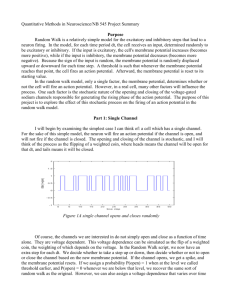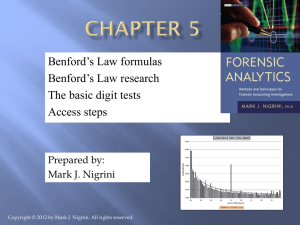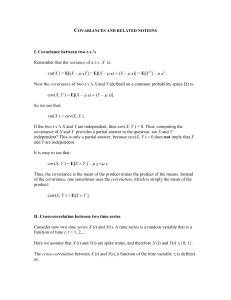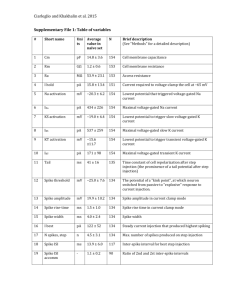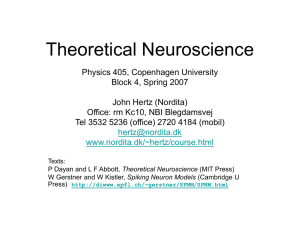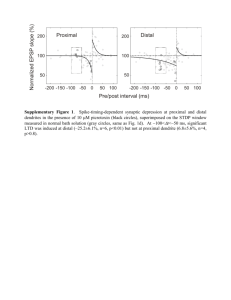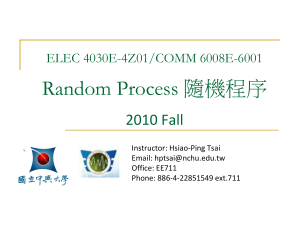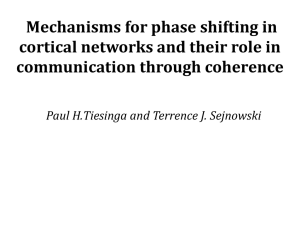Spike Train Statistics
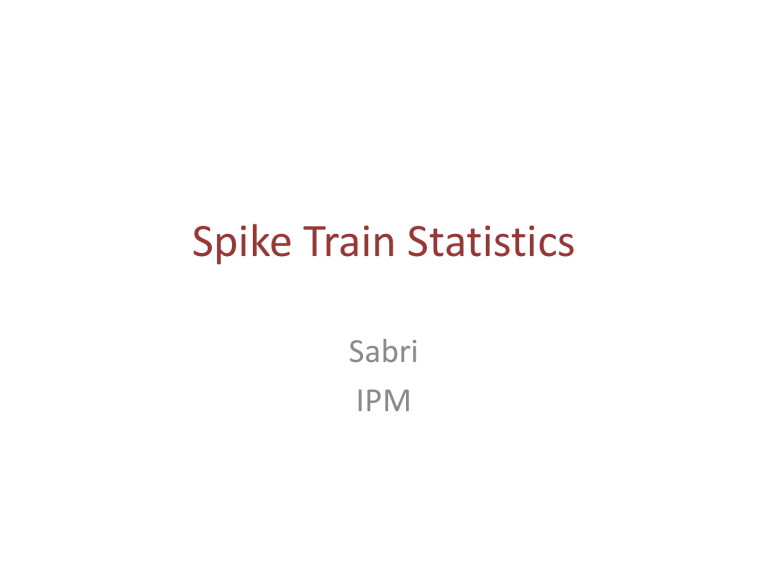
Spike Train Statistics
Sabri
IPM
Review of spike train
Extracting information from spike trains
Noisy environment:
in vitro
in vivo
measurement
unknown inputs and states
what kind of code:
rate: rate coding (bunch of spikes)
spike time : temporal coding (individual spikes)
[Dayan and Abbot, 2001]
Non-parametric Methods
recording stimulus repeated trials
Information is in the difference of firing rates over time
Firing rate estimation methods:
• PSTH
• Kernel density function stimulus onset stimulus onset
Parametric Methods
recording stimulus repeated trials stimulus onset stimulus onset
Fitting P distribution with parameter set: 𝜃
1
, 𝜃
2
, …, 𝜃 𝑚
Parameter estimation methods:
• ML – Maximum likelihood
• MAP – Maximum a posterior
• EM – Expectation Maximization
Two sets of different values for two raster plots
Models based on distributions: definitions & symbols
Fitting distributions to spike trains:
P [] : probability of an event (a single spike) p [] : probability density function
Probability corresponding to every sequence of spikes that can be evoked by the stimulus:
Joint probability of n events at specified times
P
t
1
, t
2
, , t n
t
1
, t
2
, ,
Spike time:
t i
, t n t i
n
t
Discrete random processes
Point Processes:
The probability of an event could depend of the entire history of proceeding events
Renewal Processes
The dependence extends only to the immediately preceding event
Poisson Processes
If there is no dependence at all on preceding events t i-1 t i t
Firing rate:
r
The probability of firing a single spike in a small interval around t i
Is not generally sufficient information to predict the probability of spike sequence
If the probability of generating a spike is independent of the presence or timing of other spikes , the firing rate is all we need to compute the probabilities for all possible spike sequences repeated trials
Homogeneous Distributions: firing rate is considered constant over time
Inhomogeneous Distributions: firing rate is considered to be time dependent
Homogenous Poisson Process
Poisson: each event is independent of others
Homogenous: r
r the probability of firing is constant during period T
Each sequence probability:
….
0 t
1 t i t n
T
P
t
1
, t
2
, , t n
P
t
1
'
, t
2
'
, , t n
'
n !
P
T
t
T n
P
T
n !
e
rT
: Probability of n events in [0 T]
[Dayan and Abbot, 2001] rT=10
Fano Factor
Distribution Fitting validation
The ratio of variance and mean of the spike count
For homogenous Poisson model:
2 n
n
rT
n
2 n
MT neurons in alert macaque monkey responding to moving visual images:
(spike counts for 256 ms counting period,
94 cells recorded under a variety of stimulus conditions)
[Dayan and Abbot, 2001]
Interspike Interval (ISI) distribution
Distribution Fitting validation
The probability density of time intervals between adjacent spikes
Interspike interval
t i t i+1
for homogeneous Poisson model: P
t i
1
t i
t
r
te
r
p
re
r
MT neuron
[Dayan and Abbot, 2001]
Poisson model with a stochastic refractory period
Coefficient of variation
Distribution Fitting validation
In ISI distribution:
C v
For homogenous Poisson: C v
1 a necessary but not sufficient condition to identify Poisson spike train
For any renewal process, the Fano Factor over long time intervals approaches to value C v
2
Coefficient of variation for V1 and
MT neurons compared to Poisson model with a refractory period:
[Dayan and Abbot, 2001]
Renewal Processes
For Poisson processes: P
For renewal processes: P t i
t i
t t
t i t i
t
t
r
H
t
t
0
in which t
0 is the time of last spike
And H is hazard function
By these definitions ISI distribution is: p
H
exp
Commonly used renewal processes:
Gamma process: (often used non Poisson process) p
R
R
1 e
R
C v
1
Log-Normal process: p
2
1
exp
log
2
2
2
R
exp
2
2
0
H
d
C v
exp
1
Inverse Gaussian process: p
2
C
v
1
R
3 exp
C v
2
2
R
1
2
R
ISI distributions of renewal processes
[van Vreeswijk, 2010]
Gamma distribution fitting
spiking activity from a single mushroom body alpha-lobe extrinsic neuron of the honeybee in response to N=66 repeated stimulations with the same odor
[Meier et al., Neural Networks, 2008]
Renewal processes fitting
spike train from rat CA1 hippocampal pyramidal neurons recorded while the animal executed a behavioral task
Inhomogeneous Gamma
Inhomogeneous Poisson
Inhomogeneous inverse Gaussian
[Riccardo et al., 2001, J. Neurosci. Methods]
Spike train models with memory
Biophysical features which might be important
Bursting: a short ISI is more probable after a short ISI
Adaptation: a long ISI is more probable after a short ISI
Some examples:
Hidden Markov Processes:
The neuron can be in one of N states
States have different distributions and different probability for next state
Processes with memory for N last ISIs: p
n
|
n
1
,
n
2
, ,
n
Processes with adaptation
Doubly stochastic processes
Take Home messages
A class of parametric interpretation of neural data is fitting point processes
Point processes are categorized based on the dependence of memory:
Poisson processes: without memory
Renewal processes: dependence on last event (spike here)
Can show refractory period effect
Point processes: dependence more on history
Can show bursting & adaptation
Parameters to consider
Fano Factor
Coefficient of variation
Interspike interval distribution
Spike train autocorrelation
Distribution of times between any two spikes
Detecting patterns in spike trains (like oscillations)
Autocorrelation and cross-correlation in cat’s primary visual cortex:
Cross-correlation:
• a peak at zero: synchronous
• a peak at non zero: phase locked
[Dayan and Abbot, 2001]
Neural Code
In one neuron:
Independent spike code: rate is enough (e.g. Poisson process)
Correlation code: information is also correlation of two spike times
(not more than 10% of information in rate codes, Abbot 2001)
In population:
Individual neuron
Correlation between individual neurons adds more information
Synchrony
Rhythmic oscillations (e.g. place cells)
[Dayan and Abbot, 2001]

